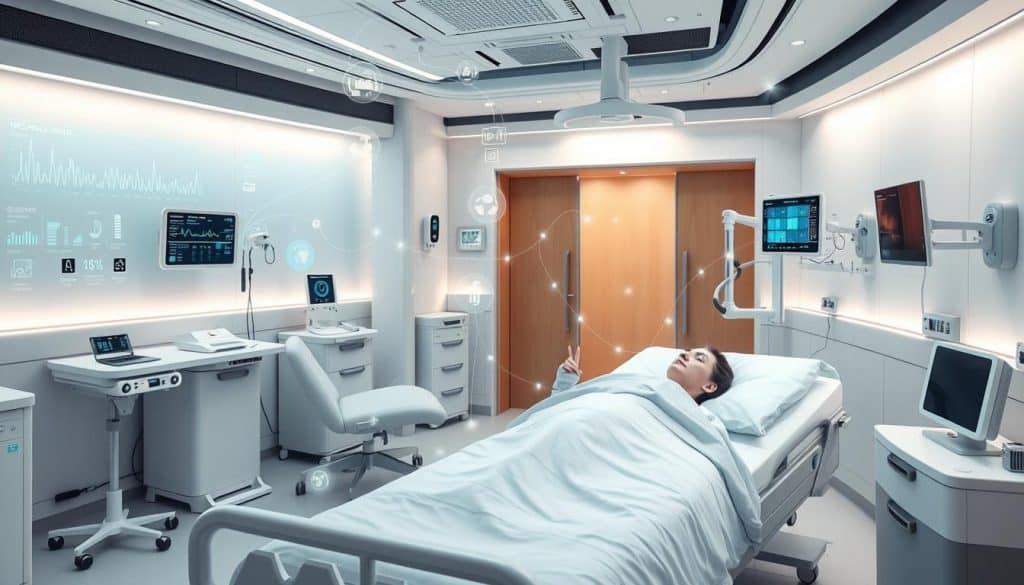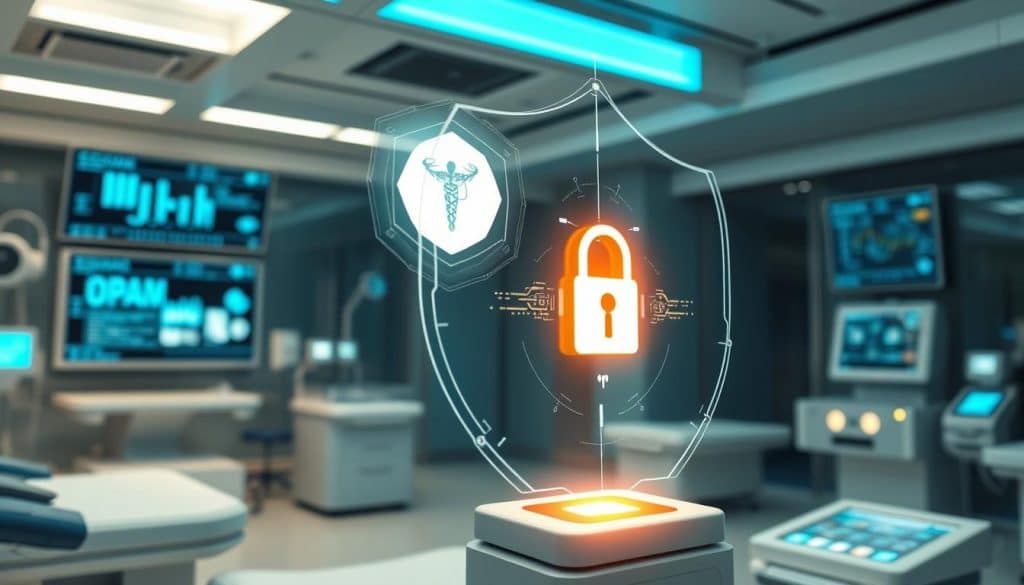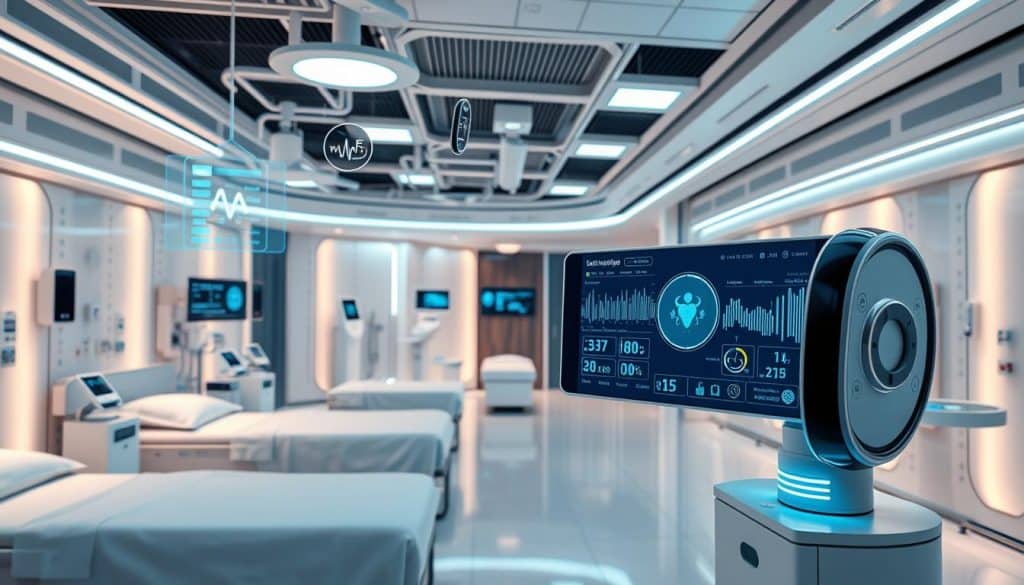The healthcare world is changing fast. Internet of Things (IoT) tech is key to this change. But, adding IoT to medical devices is hard.
A study says the healthcare IoT market will hit $534.3 billion by 2025. It will grow 19.9% each year from 2020 to 2025. Healthcare teams and device makers face many problems as they try to use IoT in medical devices.

Key Takeaways
- The global healthcare IoT market is expected to reach $534.3 billion by 2025, growing at a CAGR of 19.9% from 2020 to 2025.
- Healthcare providers and device manufacturers face numerous challenges in integrating IoT technology into medical devices.
- Security and data privacy concerns are paramount in the healthcare IoT landscape.
- Interoperability between legacy and modern systems is a significant hurdle.
- Regulatory compliance and adherence to industry standards are critical for successful IoT integration.
Understanding the Current Healthcare IoT Landscape
The healthcare world has changed a lot with the Internet of Things (IoT). Now, we have connected medical devices and smart hospitals. These changes help us watch patients better, make smarter choices, and get better results.
Evolution of Connected Medical Devices
Many new devices have come out in healthcare IoT. We have wearable trackers and systems to watch patients from afar. These tools help patients help themselves and doctors make better choices.
Market Growth and Technology Adoption
The healthcare IoT market is growing fast. People want care that fits them and uses data. Hospitals are using smart tech to work better, save money, and help patients more.
Key Stakeholders in Healthcare IoT
- Patients: They can manage their health with wearable trackers and remote monitoring.
- Healthcare providers: Doctors and nurses use IoT to care for patients better and make informed decisions.
- Healthcare organizations: Hospitals and clinics use smart tech to work more efficiently and save money.
- Device manufacturers: Companies make new IoT solutions, like wearable devices and connected medical gear.
- Regulatory bodies: Groups like the FDA help set rules for using IoT in healthcare.
Healthcare IoT is changing the industry. It makes care more personal, data-driven, and efficient. Knowing about this trend is key for everyone in healthcare to use it well.
| Key Segment | Market Size (2021) | Projected Growth (2022-2027) |
|---|---|---|
| Wearable Health Trackers | $42.1 billion | 15.9% CAGR |
| Smart Hospital Solutions | $27.3 billion | 18.2% CAGR |
| Remote Patient Monitoring | $35.8 billion | 16.1% CAGR |
The healthcare IoT world is changing fast. Devices, smart hospitals, and remote monitoring are growing the market. Knowing who is involved and the trends is important for healthcare to use this technology fully.
Security and Data Privacy Concerns in Healthcare IoT
The healthcare world is getting better with the Internet of Things (IoT). But, we must focus on keeping things safe and private. Connected medical devices, like wearables and diagnostic tools, bring new risks.
Many IoT devices are not secure. This makes it easy for bad guys to get into patient data or mess with healthcare. Patient data is also at risk because of these devices. They collect a lot of personal and health info that needs to be kept safe.
Following rules is hard in the IoT healthcare security world. Healthcare places must follow laws like HIPAA to protect patient data. If they don’t, they could face big fines and lose people’s trust.
| Potential Security Risks in Healthcare IoT | Potential Privacy Concerns in Healthcare IoT |
|---|---|
| Unauthorized access to connected devices Malware and ransomware attacks Data breaches and theft of sensitive information Disruption of critical healthcare operations | Unauthorized access to patient medical records Misuse of personal health data Lack of transparency in data collection and sharing Compliance challenges with data privacy regulations |
Healthcare groups need to get serious about IoT healthcare security. They should use strong encryption, good login systems, and systems to find and fix threats. It’s also key to teach everyone about keeping data safe and private.
“Safeguarding patient data privacy and the security of connected medical devices is not just a regulatory imperative – it is a moral obligation that healthcare providers must uphold to maintain the trust of their patients.”
By tackling these big issues, healthcare can really benefit from IoT. This way, they can keep patient info safe and keep healthcare running smoothly.

IoT Integration for Healthcare Devices: Implementation Barriers
Adding IoT tech to healthcare devices is hard. Health groups want to use smart tech and IoT. But, they face many hurdles.
Technical Infrastructure Requirements
IoT needs a strong tech setup. Hospitals must have good internet, storage, and data handling. They also need to update old systems and connect new devices smoothly.
Cost and Resource Allocation
IoT costs a lot. Health groups have to spend on new tech, training, and upkeep. It’s hard to balance these costs with the benefits.
Staff Training and Adaptation
- Teaching staff about IoT devices is key.
- Health workers need to learn new ways of working and data handling. This is a big change.
- Helping staff adjust to new tech is important. They need ongoing support.
Getting past these barriers needs a good plan. It must tackle tech, money, and staff issues. This way, health groups can fully use IoT integration for healthcare devices, smart hospital solutions, and healthcare IoT.

Interoperability Issues Between Legacy and Modern Systems
Getting old healthcare systems to work with new IoT devices is hard. The main problem is that old tech can’t talk to new tech. This is because old systems don’t have the right ways to connect with connected medical devices and IoT integration for healthcare devices.
Another big problem is that healthcare doesn’t have one set of rules for all. This means each device or system uses its own way to talk. This makes it hard to share data and work together, holding back the benefits of IoT in healthcare.
- Old systems use outdated tech, making it tough to link up with new IoT devices.
- Different data formats, ways to talk, and software interfaces block easy data sharing.
- This lack of connection leads to slow work, data stuck in silos, and missed chances for better patient care.
To fix these problems, healthcare providers, tech makers, and rules makers need to work together. They must create common rules for all. This way, old and new systems can work together smoothly, making healthcare better and more connected.
“Achieving interoperability is not just a technical challenge; it’s a strategic imperative for the healthcare industry to unlock the full potential of connected medical devices and IoT integration.”
Regulatory Compliance and Standards in Medical IoT
The healthcare world is changing fast with the Internet of Things (IoT). It’s hard to keep up with all the rules for IoT security and data. Hospitals must follow many guidelines to keep patient info safe.
FDA Guidelines and Requirements
The U.S. Food and Drug Administration (FDA) helps control IoT in healthcare. Device makers must follow strict rules. They need to get approvals, keep data safe, and watch for security problems.
HIPAA Compliance Challenges
Healthcare groups also have to follow HIPAA rules. This is tough with IoT because it’s hard to keep all data safe. They must protect health info on many devices.
International Standards and Protocols
IoT in healthcare must also meet global standards. Groups like ISO and IEC set rules for safety and working together. Hospitals need to know these rules to use IoT devices worldwide.
It’s a big challenge for hospitals to follow all these rules. They want to use new IoT tech but must keep patient info safe. It’s a balance between following rules and being innovative.
Remote Patient Monitoring Challenges
Using remote patient monitoring (RPM) in healthcare has its own set of challenges. It needs to work well with IoT devices and wearable health trackers. As more people need care from home, we must deal with data accuracy, patient use, and fitting these new tools into current systems.
One big worry is making sure the data from these devices is right. These devices must be checked and kept up to date. If the data is wrong, doctors might not treat patients right, which is bad for everyone.
Getting patients to use these devices is also hard. They need to use them often and tell doctors about any changes. It’s important to make patients feel like they’re part of their care team.
Another problem is getting the data from these devices to work with what doctors already use. It’s important for doctors to see this data right away. This helps them make good choices and help patients fast. But, getting these systems to talk to each other is a big challenge.
| Challenge | Description |
|---|---|
| Data Accuracy | Ensuring the reliability and precision of data collected by IoT devices and wearable health trackers |
| Patient Compliance | Engaging patients to regularly use IoT devices and report changes in their condition |
| Integration with Clinical Systems | Seamlessly integrating remote patient monitoring data with electronic health record (EHR) systems and clinical workflows |
To solve these problems, healthcare needs to focus on better data handling, teaching patients, and making sure all systems work together. By working on these areas, we can make care better, more personal, and easier to get for everyone.
Network Reliability and Data Management
Healthcare systems are using the Internet of Things (IoT) more. They need strong networks and good data management. IoT devices make lots of data fast. This data must be sent safely and quickly for medical decisions.
Bandwidth Requirements
Healthcare IoT needs lots of bandwidth. This is for things like watching patients closely, using high-definition images, and telemedicine. Hospitals must have good networks for these to work well.
Data Storage Solutions
IoT devices make a lot of data. Hospitals need to store this data well. They can use on-site or cloud storage. Good data management helps use IoT data better.
Real-time Processing Demands
Many IoT apps in healthcare need data fast. This includes watching patients from afar and changing treatments quickly. Hospitals need strong analytics and computers for this. It helps patients get better care.
What are the top challenges in IoT integration for healthcare devices?
The main challenges include keeping data safe and private. We also need a good technical setup and enough money. Training staff and making sure old systems work with new ones are also big hurdles.
How has the healthcare IoT landscape evolved?
The healthcare IoT world has grown fast. More medical devices are connected now. Key players like doctors, device makers, and tech firms are all involved.
What are the security and data privacy concerns associated with healthcare IoT?
Security and privacy are big worries. Connected devices can be vulnerable. We must protect patient data by following rules like HIPAA.
What are the implementation barriers for IoT integration in healthcare devices?
Setting up IoT needs strong tech and money. Training staff to use new devices is also hard.
How do interoperability issues between legacy and modern systems impact healthcare IoT integration?
Old and new systems not working together is a big problem. They need to talk and share data well for good care. Making sure they all use the same standards helps.
What are the regulatory compliance and standards requirements for medical IoT?
Medical IoT must follow many rules. This includes FDA and HIPAA guidelines. It’s important to know and follow these rules to use IoT devices well.
What are the challenges associated with remote patient monitoring using IoT devices?
Watching patients from afar is tricky. We need to make sure the data is right. Getting patients to wear trackers and making sure devices talk to systems are also big tasks.
How do network reliability and data management impact healthcare IoT?
A good network and data storage are key. They help make sure medical decisions are based on the right info. This is very important for patient care.

